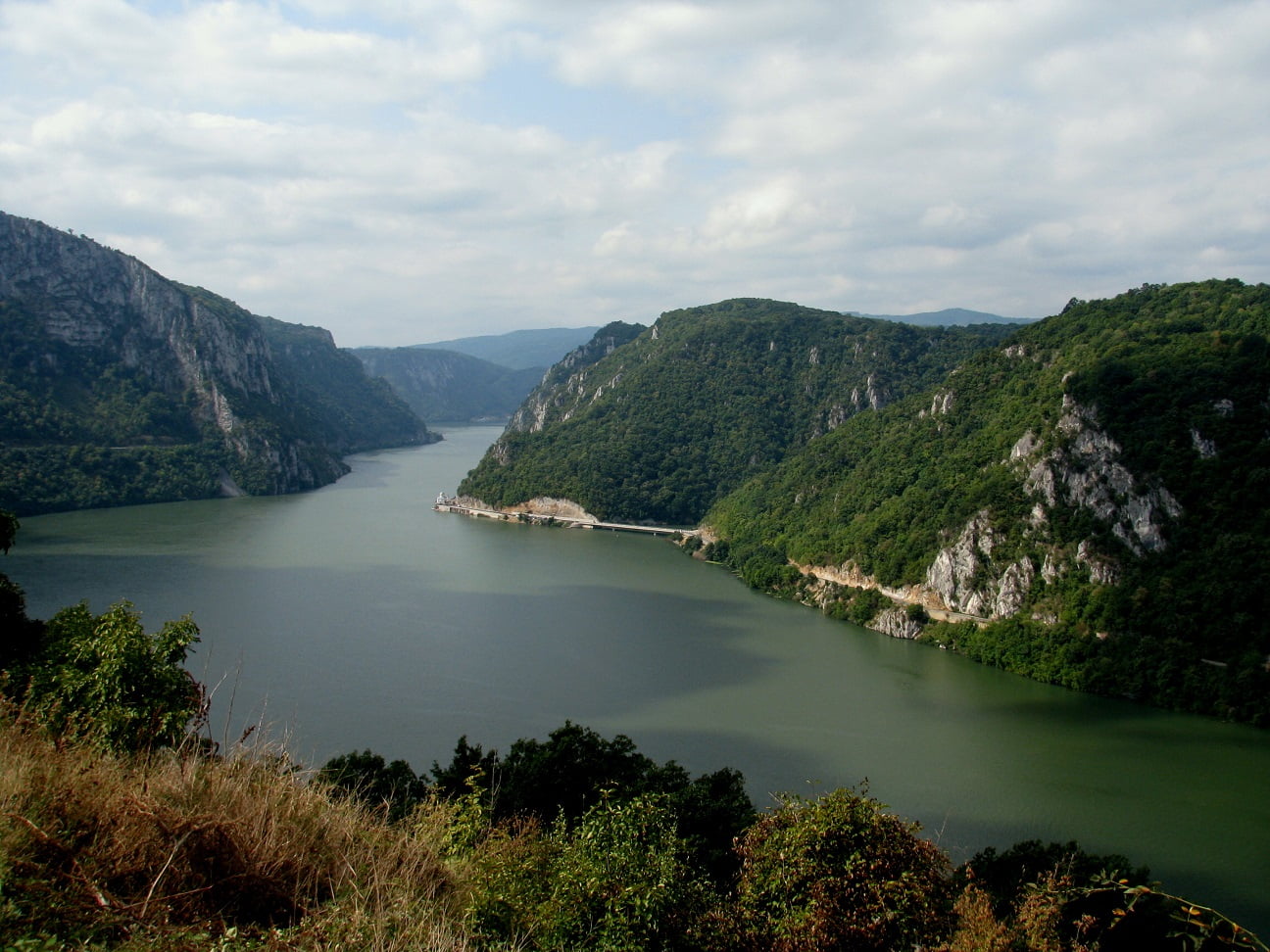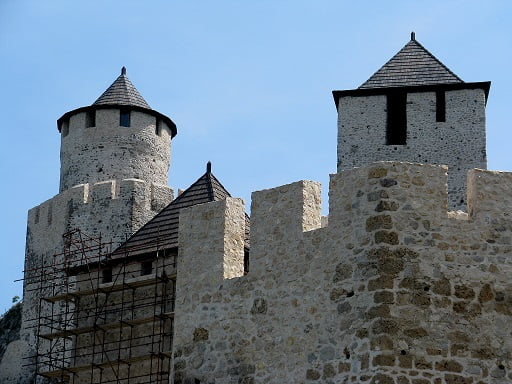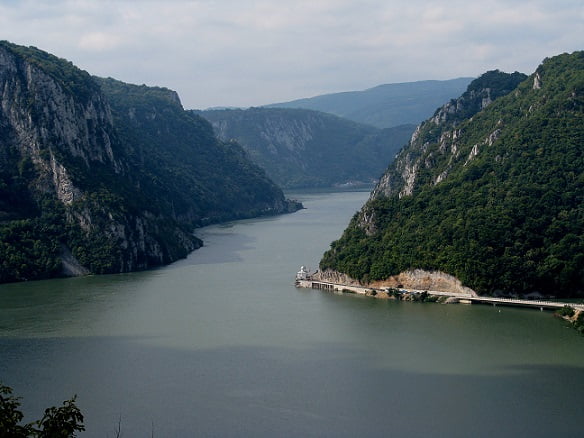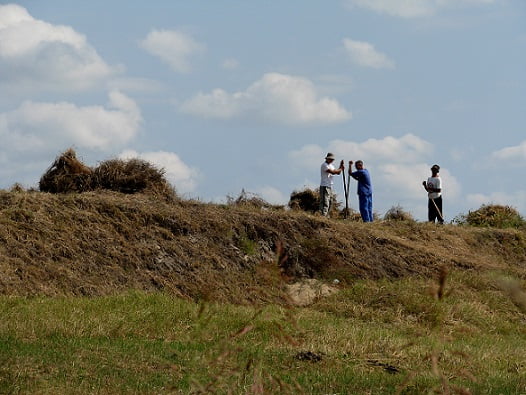
If you need a freelance travel writer or you would like to see your country, city, flight, etc., presented on the blog, drop me an email.
Find our more on Freelance Travel Writer page.
Đerdap Gorge (also known as the Iron Gate Serbia) is a place I’ve had the pleasure of visiting multiple times—in the company of tourists on a bus while cruising along the Danube River by boat, and on my own by car. And guess what? I recently went back again!

To be honest, I could hardly wait to revisit the Golubac Fortress, the gateway to Đerdap National Park, and to see the archaeological site of Lepenski Vir, which I’d heard has undergone some changes. This time, I also seized the chance to finally explore Trajan’s Plaque and the Diana Fortress near the town of Kladovo—both of which pleasantly surprised me. But I’m getting ahead of myself, diving into memories and skipping ahead in the story. Let’s take it one step at a time and explore each place properly.
FROM BELGRADE: About 130 km (take the highway to Požarevac – 80 km)
FROM NIŠ: About 240 km (take the highway to Požarevac – 195 km)
If you’re driving, the easiest route to Đerdap is via the highway to Požarevac, followed by about 50 kilometers to Golubac. The journey takes around two hours.

On my recent trip, I opted for the road from Belgrade to Donji Milanovac, another town along the route about 60 kilometers from Golubac. Instead of following the Danube River from Golubac, I took the road through Majdanpek. While it made for a longer journey, it was an absolute delight to drive through the charming hills and fertile meadows, occasionally intersected by rustic railroad tracks. Every time I slowed down at a railway crossing—marked only by road signs, without ramps—I would glance at the grass-covered tracks and think, “There’s no way trains still run here.”
That was until I caught sight of an actual train! A small one, admittedly, but still enough to make me gasp in amazement.

The road from Majdanpek through Đerdap National Park is an adventure in itself. There are two routes: a longer, 50-kilometer stretch with steady descents and moderate speed limits, and a shorter, 28-kilometer route that winds through dense forest, requiring you to slow down to as little as 30 km/h at times. Naturally, I chose the latter! (I even posted a short video of the drive on social media.)
But oh, the reward when you emerge from the woods! The stunning view of the Danube River is worth every twist and turn of the road. Truly, it’s a sight to behold and one that stays with you long after the journey ends.

Golubac Fortress
There is no definitive record of who originally built Golubac Fortress, but its construction reflects the Serbian fortification style of the 13th and 14th centuries. For this reason, it is widely believed to date back to the era of King Dragutin. Over the centuries, the fortress was a focal point of constant battles between the Serbs, Hungarians, and Turks, leading to frequent changes in rulers. Today, it stands as part of the Đerdap National Park, nestled within the Iron Gate Serbia region. The surrounding area, including the natural reserve of Golubac town, is home to rare species of flora and fauna. Here, the Danube reaches its widest expanse—an impressive 6.2 kilometers.
One of the many legends surrounding Golubac Fortress tells the story of a Turkish general who sought to marry a Serbian princess. When she refused, he imprisoned her in the so-called Hat Tower of the fortress. Her only companions were pigeons, with whom she shared her meager food rations. Later, the general exiled her to the desolate rock of Baba-Kaj, situated across the river—its name meaning “Repent!” in Turkish. Miraculously, the pigeons followed her, bringing food to sustain her. Thus, the name Golubac was born, derived from the Serbian word golub meaning “pigeon.”
I was pleasantly surprised when I arrived at the fortress. The last time I visited, the main road ran straight through the fort. Now, a separate tunnel has been constructed to preserve the site. There is also a proper parking area and a spot for coffee and refreshments, making the entire location far more welcoming.
As I strolled along the Danube River, I couldn’t resist taking countless photos of the imposing fortress walls. I glanced toward the Hat Tower several times, imagining the princess and her loyal pigeons. And you know what? Although her story is more of a romantic legend than a historical fact, standing there by the tower—watching pigeons endlessly flying in and out of its crevices—it’s easy to believe that this must be the place where it all happened.

(By the way, a word of caution: Golubac marks the point where your phone might start roaming, as Romanian networks begin to interfere.)
I paused for a short break, savoring a coffee and ice cream with a view of the romantic fortress and the serene waters of the Danube. Soon, I was eager to continue my journey to Donji Milanovac, just an hour away, where I planned to visit the fascinating archaeological site of Lepenski Vir.

Lepenski Vir
The archaeological site of Lepenski Vir, located about 15 km from the town of Donji Milanovac, is a fascinating window into the past. Nestled in the picturesque Iron Gate Serbia region, this site reveals the story of a densely populated settlement where people lived more than 8,000 years ago. Due to the construction of the nearby dam, the entire site had to be relocated.
Numerous artifacts were unearthed here, including fireplaces, a necropolis, fish-shaped sculptures, and various tools. Many of these discoveries, such as tools, jewelry, and figurines, are now displayed in the museum. Visitors can also watch an original documentary filmed in the 1960s during the excavation, which brings the site’s history to life.
There’s a small restaurant near the parking lot, and a short 10-minute walk leads you to the museum complex itself.
I had heard that “the new museum looks nice” and that it’s certainly worth visiting. That was all the encouragement I needed—I was on my way. The museum’s massive white structure is striking, especially with its expansive windows offering stunning views of the Danube. However, it can feel a bit stifling on hot days—like being inside a greenhouse.

The old documentary shown at the museum initially caught me off guard, as the quality of the film seems to teeter on the brink of disappearing entirely. Yet, this sense of fragility adds a unique authenticity to the experience, and I found myself loving it in the end.
(Also, don’t forget to bring some cash if you plan to grab a coffee at the small café outside. Bank cards haven’t quite made it to this charming corner of Iron Gate Serbia.)

Donji Milanovac
This is a charming town nestled on the banks of the Danube, with a population of fewer than 3,000 residents. It owes its name to the Serbian King Milan, who supported the locals during a historical relocation of the settlement. However, after roughly a century, the town had to move again, this time due to the construction of a dam in the mid-20th century. As a result, the old town now lies submerged beneath the Danube’s waters, while the new Donji Milanovac continues to attract more and more visitors each day.
The locals often joke that they’re ready for another relocation because “almost a century has passed since the last one.”
On this visit, I only passed through the town, but a few years ago, I spent the night here. Finding accommodation is easy—you just need to contact the town’s tourist info center in advance. When you’re in Donji Milanovac, take a leisurely walk through its streets towards the church or enjoy a tranquil stroll along the riverbank. To be honest, every small town along the Danube River feels magical at sunset, with the sky painted in breathtaking shades of purple.
From the town’s port, you can embark on a cruise through parts of Iron Gate Serbia—including the Small and Great Kazan basins—or continue exploring by car. If you’ve ever wondered about the origin of the gorge’s name, it literally translates to “gates made of steel” in various languages. The London Times referred to it in the mid-19th century as “the Iron Gate or the Gate of Trajan.” In Serbian, the basins are called kazan, which means “pot.” This name becomes self-explanatory as the Danube dramatically narrows from 6.2 kilometers in Golubac to just 150 meters, creating a powerful and restless flow full of whirlpools that resemble a boiling pot. Hence, the names Small and Great Kazan (Basin) of the Đerdap Gorge.

As I mentioned, I’ve traveled through this part of Serbia several times—both by boat and by car—and I strongly recommend experiencing it both ways! If you’re driving, you’ll encounter numerous scenic viewpoints offering stunning panoramas of the gorge and its dramatic cliffs. But if you don’t take the cruise from Donji Milanovac to the town of Tekija, where the National Park officially ends, you’ll miss the chance to see the iconic Tabula Traiana—a Roman plaque carved into the rock to commemorate Emperor Trajan’s road through the gorge.

Tabula Traiana
This inscribed plaque was placed by the Roman Emperor Trajan nearly 1,900 years ago to commemorate the completion of the famous Roman road along the Danube River. The monument dates back to Trajan’s conquest of Dacian lands between 100 and 103 AD and stands as a testament to his numerous engineering achievements. The Tabula’s dimensions are 3.20 x 1.80 meters. At its center is an inscription, surrounded by decorative carvings of two dolphins, roses, and an eagle.
When the Iron Gate Serbia dam was constructed, the plaque was relocated 20 meters higher up the cliff to protect it from flooding. Today, it can only be seen from the river.

Visiting Trajan’s plaque was a promise I made to myself a few years ago when I drove through the breathtaking Iron Gate Serbia region. Back then, I missed the opportunity to take a cruise or rent a boat, so the visit remained on hold—until now.

The cruise was delightful, typically running from Donji Milanovac to Tekija. Along the way, you’ll hear stories about how the mighty emperor built the Roman road here, a marvel of engineering that was submerged when the dam was constructed in the 1970s. The landscape becomes more dramatic as you approach the sharp cliffs plunging into the river, and there, beneath one of them, gleams the Tabula Traiana. The white plaque bears the inscription, its letters a silent witness to the countless waters that have flowed through this historic passage over the centuries.

Decebalus Head
Decebalus, the last Dacian king, fiercely resisted Roman advances but was ultimately defeated by Trajan. Surrounded by Roman troops in 106 AD, the king chose to commit suicide rather than surrender. His fall marked the end of Trajan’s relentless campaign in Dacia and the beginning of a new era, symbolized by the extensive infrastructure the Romans built on the Serbian side of the Danube—roads, bridges, and fortifications.
The sculpture of Decebalus, carved into a cliff on the Romanian side of the gorge, is the largest of its kind in Europe. Towering at 40 meters, the king’s eye alone measures 4.3 meters, while his nose spans an impressive 7 meters. It took 12 skilled alpine carvers a decade to complete this masterpiece, which was finished in 2004.

As you cruise through the gorge, keep an eye out for a small church that seems to rise from the river. Not far from it, you’ll spot the famous Dacian king’s head etched into the rock—a poignant reminder of a time when this very region was ruled by Decebalus. It struck me as fascinating that the sculpture is so “young” compared to the ancient history it commemorates.

The journey through the Iron Gate Serbia region was a magnificent way to explore this historic gorge. From Tekija, it’s a short, 30-minute drive to Kladovo, even though the Đerdap National Park officially ends at Tekija. This time, I made sure to “correct” my earlier itinerary. I visited the Diana fortification, which I had missed before, and took some time to explore Kladovo itself.
Diana
This ancient fortified town lies on the banks of the Danube, built to secure river traffic and support the Dacian war efforts of the Roman army. Constructed at the end of the 1st century during Emperor Trajan’s reign, the fort was repeatedly destroyed, conquered, and rebuilt by various invaders such as the Goths, Huns, and the Byzantine Empire. However, by the end of the 6th century, it succumbed to the relentless onslaught of new invaders.

When you approach the actual dam, about 7 km before Kladovo, keep an eye out for a modest sign on the left. The site’s surroundings may seem unremarkable as you stop near the main road. From a distance, the fort’s oval walls appear impressive, but up close, they are mostly overgrown with grass. I found myself leaping from one stone to the next (there are no fences, gates, or guards) while trying to connect the many historical dots of the Iron Gate Serbia region that were forming in my mind.

Just imagine: you’re traveling along the same route once traversed by the Roman road that Emperor Trajan planned and built in the 1st and 2nd centuries AD. One point leads to another—fortresses, the sculpture of Decebalus, Trajan’s Plaque, and even a colossal bridge in the Kladovo area.

Kladovo
With a population of about 10,000, Kladovo is Serbia’s final frontier before Bulgaria and Romania. The town lies 260 km from Belgrade and 200 km from Niš. It features two small lakes in its center, a pleasant marina, a charming riverfront, and a lovely beach.

My first impression of Kladovo was that it’s a clean, well-organized little town on the river. I parked near one of the lakes and decided to explore on foot before settling down for coffee.
The heart of the town boasts a short pedestrian street lined with cafés and restaurants, leading to a small square dominated by a church. It was hot that day, and I couldn’t resist stopping for some ice cream at a nearby shop—a delightful treat, as it turned out! As I wandered, I noticed that Kladovo had everything one might need, but it wasn’t until I turned toward the river that I realized I was in for a special evening.
I found myself at the Aquastar Danube Hotel café, situated next to the beach. (I spent a night here.) As the sun set, it painted the gorge in the distance with a delicate rose hue, creating a breathtaking scene that perfectly encapsulated the tranquil charm of Iron Gate Serbia.

Trajan’s Bridge
The remnants of Trajan’s Bridge—specifically, one pillar—can be found in the village of Kostol, near Kladovo. Built in 105 AD under the direction of the renowned architect Apollodorus of Damascus, this engineering marvel stretched almost 1,100 meters across the Danube. For nearly a millennium, it was considered one of the longest bridges ever constructed.
The bridge, completed in just two years (103–105 AD), stood an impressive 45 meters above the water and consisted of 20 massive stone pillars, with monumental portals at each end. It is famously depicted on Trajan’s Column in Rome. Although the bridge was destroyed not long after its construction, reports from 1856 suggest that traces of all 20 pillars were still visible when the Danube’s water level was exceptionally low.

When I visited the site a few years ago, I couldn’t help but feel a twinge of disappointment. Having read so much about Emperor Trajan’s engineering feats, I had envisioned a grand, imposing structure. Instead, all that remains is a solitary brick pillar jutting out of the Danube’s shallow waters.
The historical significance, however, was undeniable.

To reach the site, I nearly parked in a cornfield and trudged through high grass with my camera in hand, all while curious locals tended their fields.

Standing there, I tried to picture the Romans crossing the Danube, which is 800 meters wide at this point, into Dacia. For the Dacians, the river was supposed to serve as a natural barrier, but Trajan overcame it with ingenuity, building his bridge and marching his army across.

My journey through Iron Gate Serbia was like tracing the footsteps of a Roman emperor. Perhaps one day this trip could be organized as a special tour—“Following in Trajan’s Footsteps to Dacia.” For me, it was an unforgettable adventure, even 2,000 years after the events it commemorates.
Next destination – GEMS OF EASTERN SERBIA
The full THINGS TO DO IN SERBIA section
PIN IT FOR LATER:

If you need a freelance travel writer or you would like to see your country, city, flight, etc., presented on the blog, drop me an email.
Find our more on Freelance Travel Writer page.
I am looking forward to working with you.




24 responses
What a fascinating read. I think you are doing the job of the Serbian tourist board; you certainly make me want to visit this beautiful-looking country! Good thing too. We don’t hear much about Serbia and all most people here in the UK know about it is the sad recent history. Thanks for sharing, I really enjoyed your post.
Oh, thank you so much, so glad you like the story. There certainly is a lot to see in this part of Europe. 🙂
Thanks for taking us on this amazing journey with you. I had no idea the Danube went that far back into Serbia, what a fantastic tour!
It really is spectacular. Danube stretches for about 2,800 km in total. It flows through or forms the border of 10 European countries, while its course through Serbia is 588 km.
Magnificent surroundings along the river, really. 🙂
What a varied trip. It’s hard to believe that you did it all in a weekend!
Gorgeous view of the gorge and waterway. I love the way you put it –“chasing images in my memory.’
I too always prefer the back roads. Love the curving roads where all you see is nature. Sounds like this trip fits that bill.
I knew nothing about Serbia, or the Golubac Fortress. The story about the imprisoned princess made me smile.
The car and boat combo is a great suggestion. I love adding a boat tour when sightseeing.
Sounds like Trajan was quite determined!
Good tip about phones!
Oh, I know. That story from Golubac made me smile as well. It’s so nice to hear something like this as well, other than data, right! It makes it even more charming. 🙂
And yes, Trajan seems like a fascinating figure, no escaping there. If he had set his eye on the country, it was Roman in no time, even if it meant building enormous constructions and crossing over the whole of Danube! 😀
Thank you, Wendy, so glad you enjoyed the article. <3
It’s my dream to see Serbia! Your photos are so lovely, too. Thanks for this guide – I’ll definitely be bookmarking 🙂
Thank you. Hope this Weekend in Serbia series will come handy when you do get the chance to visit. 🙂
Such an interesting story about the fort! Decebalus head is so amazing, what a creation actually! I am stunned.
I love this tour.
King’s head looks really impressive in person, you’re right. I actually love the whole scenery, because the sculpture seems like popping up out of those green cliffs.
Thanks, Indrani. 🙂
Your pictures and post has completely attracted us It is so damn beautiful. Those cliffs on Iron Gate Danube are so beautiful and that museum too. The fort story is interesting too. Great pictures.
Thanks, guys! <3
Hopefully, I've managed to convey the impression I got myself when driving along the Danube river. It sure is one picturesque area.
So glad you like the photos, thanks! 🙂
Visiting Eastern Europe is on my list for next year. Your article has me really excited. The Decebalus head sculpture is incredible. The views from the water are stunning. I can’t wait to visit. Thanks for the inspiration!
So glad I was able to inspire you. I’m eager to hear your impressions. 😉
It’s nice to read about Serbia rather than again and again about Croatia 😉 It is obviously as rich in history, and the sceneries on the water are just grand. I totally need to visit the Balkan countries asap.
Thank you, Renata. <3 There really is a lot to see throughout Balkans. There'll be more on Serbia in months to come, so feel free to stop by to check out the series occasionally. Thanks! 🙂
How nice! I can see we missed something important when we went to Belgrade last year The Golubac
fortress somehow reminds me of Chateau de Chillon on Lake Geneve. We did do some day trips but never knew about this place.
I know, there’s never enough time to see everything, right! It’s the same here, lots of gorgeous gems, not possible to visit in a short period of time.
Hope you liked Belgrade. As for the fortress – next time! 😉
Thanks, Nisha! <3
Decebalus head is quite amazing. Serbia is a beautiful country with rich history. Idk why but it reminds me of Tomb Raider. Haha!
Hehehe, don’t know why either. 😀 Maybe because of the wild nature, caves and cliffs etc.
What a cool fortress (and great place to stop for an ice cream!). As an American, I’m totally fascinated by castles…we don’t really have anything like that here. This definitely seems like a good trip to have a car for…I was on trains the whole time in Serbia and I feel like I missed out on a lot of the off-the-beaten-path places because the trains were just a little too confusing.
They are, I know. Train ride can get really slow in Serbia. But the country is great for road trips, indeed. Few bumps on the road, but great scenery everywhere. 🙂
And yes, the fortress is such a nice sight to visit. The river is gorgeous around here.
Thank you, Carrie. Keep this for your next Serbia visit! 😉 <3
Serbia looks beautiful! It is an offbeat place to visit and I really haven’t come across a lot of blog posts about it. I had this perception that it’s a very cold place but obviously, it looks beautiful in the summer! I love the Golubac fortress along Danube, it’s so picturesque! I did not expect so much natural beauty and wilderness but your pictures have totally inspired me!
Oh, I’m so glad you find it useful!
Yep, Serbia can get cold in winter, but the rest of the year is pretty pleasant. Summers may even get too hot.
Maybe it’s due to this type of climate that its nature is extremely lush and abundant with rivers, lakes, springs, waterfalls, mountains, forests, caves – you name it! 😀
Thank you, Medha! <3